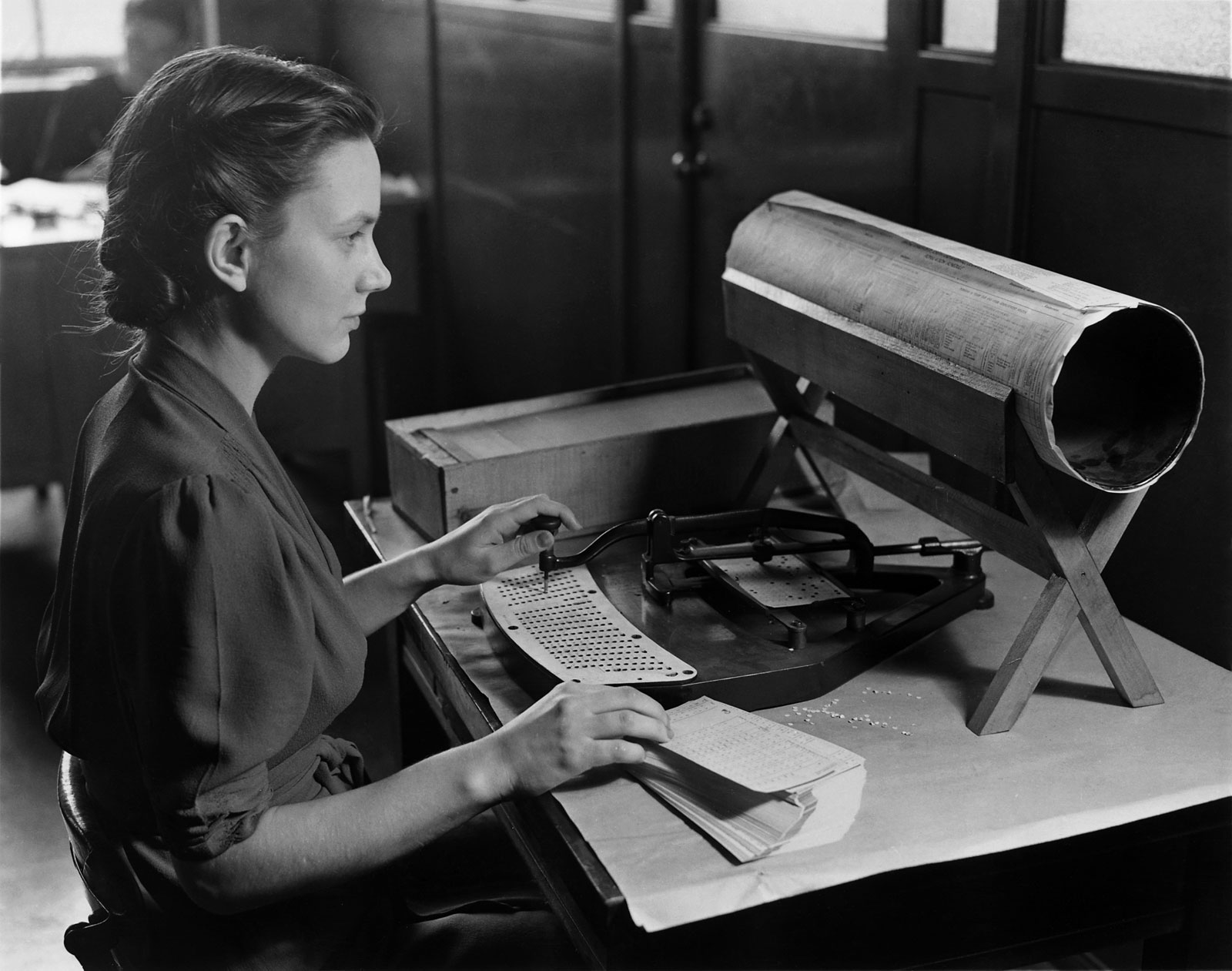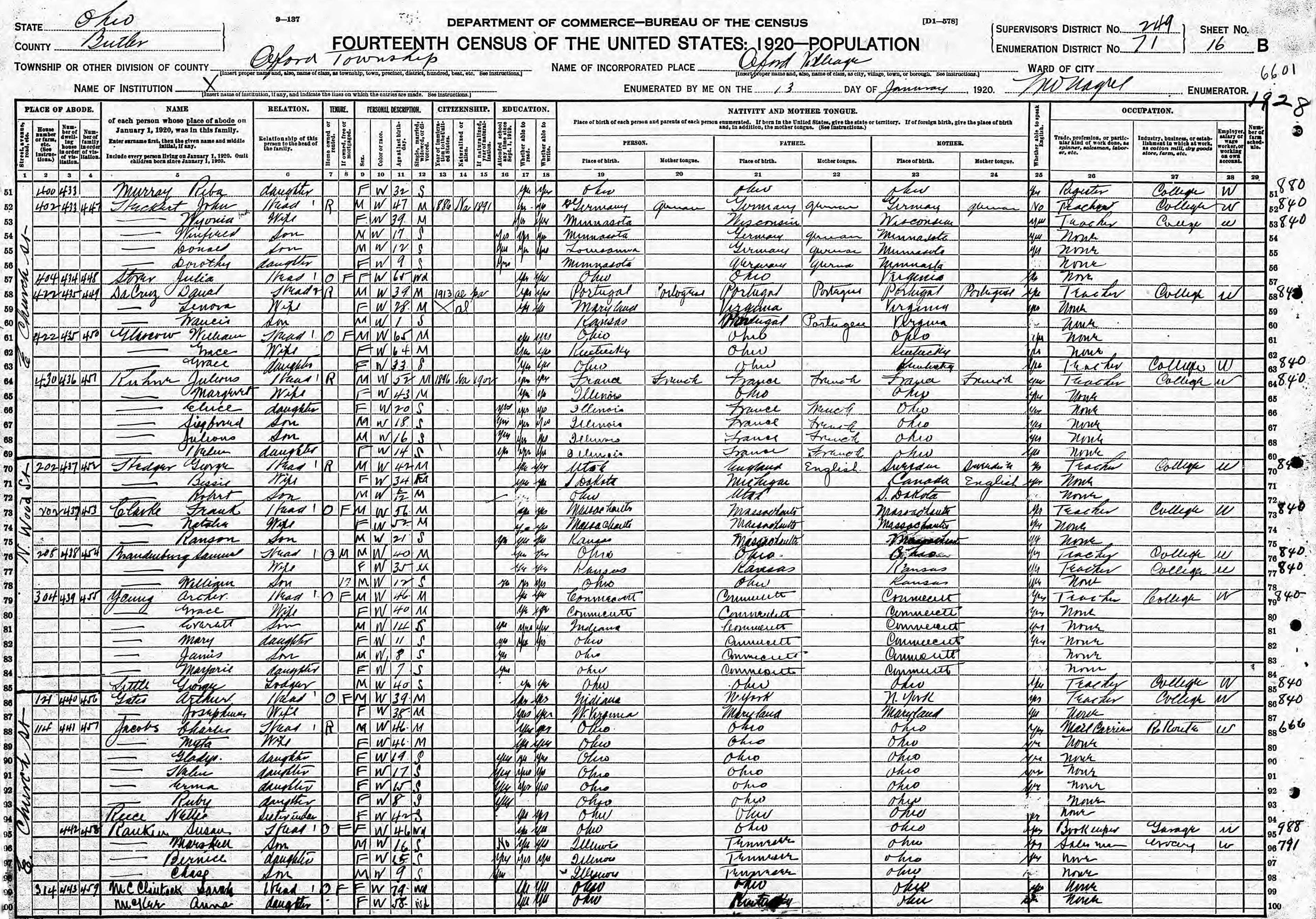Hollerith Pantographic Card Punch

|
| Photo: US NARA via Wikipedia. |

|
| 1920 census form - Click to enlarge |

|
| 1950 census transcription |
The 1950 photo shows how census forms were processed the same way as they were since 1890, but with a better card punch: the IBM 012 from 1925, that is like the numeric keypad on a modern keyboard.
By 1910, some error checking was done by the tabulators themselves... "If the entire color, for example, was left unpunched the card would fail to register and therefore fail to ring the bell for which the operator was listening. Cards were also rejected if they were 'off gauge' or otherwide mechanically defective. These rejected cards were examined and the omitted items supplied — or new cards, conforming to the mechanical requirements, were punched. In addition to these defective cards, there were many cards containing items that were so far inconsistent as to raise questions with respect to the accuracy either of the punching or of the original returns from which they were punched. The verification run of 1900 was designed to take care of both types of defective cards, in advance of the use of the cards in final tabulations, through a special machine wired to reject not only incomplete and defective cards, but also those with inconsistent items, items otherwise frequently subject to question of accuracy, and a considerable number of items of infrequent occurrence, of which it was desired to be doubly certain." [Truesdell, p.94-95]
These verification runs were perhaps the first example of "programming by wire", made possible by Hollerith's invention of the wiring panel for his Type I Tabulator in 1906.
- 1920 Overview, United States Census Bureau.
- 1920 Federal Population Census Schedule, raogk.org ("Random Acts Of Genealogical Kindness").
- U.S. Bureau of the Census Tabulating Machine, Smithsonian National Museum of American History, which notes that the 1920 census was tabulated on machines developed internally by the Census Burueau, to avoid paying rent to the Hollerith company as it did in 1890 and 1900.
- Hollerith Pantographic Card Punch, Smithsonian National Museum of American History.
- Truesdell, Leon E., The Development of Punch Card Tabulation in the Bureau of the Census 1890-1940 , Bureau of the Census, US Government Printing Office, Washington DC (1965).
Translations of this page courtesy of...
| Language | Link | Date | Translator | Organization |
|---|---|---|---|---|
| Albanian | Shqip | 2023/08/31 | Kerstin Schmidt | https://writemyessay4me.org/ |
| Belarusian | Беларуская | 2023/08/22 | Vladyslav Byshuk | Владислав Бишук | studycrumb.com |
| Bulgarian | български | 2023/08/31 | Kerstin Schmidt | admission-writer.com |
| Czech | Čeština | 2023/08/31 | Kerstin Schmidt | writemyessay4me.org |
| Finnish | Suomi | 2022/02/07 | Elsa Jansson | mysciencefeel.com |
| French | Français | 2022/05/13 | William Wright | jeuxvideos.net |
| French | Français | 2023/08/25 | Kerstin Schmidt | prothesiswriter.com |
| German | Deutsch | 2023/08/25 | Kerstin Schmidt | writemypaper4me.org |
| Hungarian | Magyar | 2023/08/31 | Kerstin Schmidt | https://admission-writer.com/ |
| Italian | Italiano | 2023/01/27 | Valeria T. | Global Translation Services |
| Macedonian | Mакедонски | 2021/05/08 | Katerina Nestiv / Катерина Нестив | Macedonia University of Science and Technology |
| Norwegian | Norsk (bokmål) | 2023/04/23 | Sondre | Hvem Eier Bilen |
| Polish | Polski | 2023/08/31 | Kerstin Schmidt | justdomyhomework.com |
| Russian | Русский | 2023/08/22 | Vladyslav Byshuk | Владислав Бишук | skyclinic.ua |
| Spanish | Español | 2023/08/31 | Kerstin Schmidt | pro-academic-writers.com |
| Swedish | Svenska | 2023/08/25 | Kerstin Schmidt | justdomyhomework.com |
| Ukrainian | Українська | 2023/08/22 | Vladyslav Byshuk | Владислав Бишук | studybounty.com |